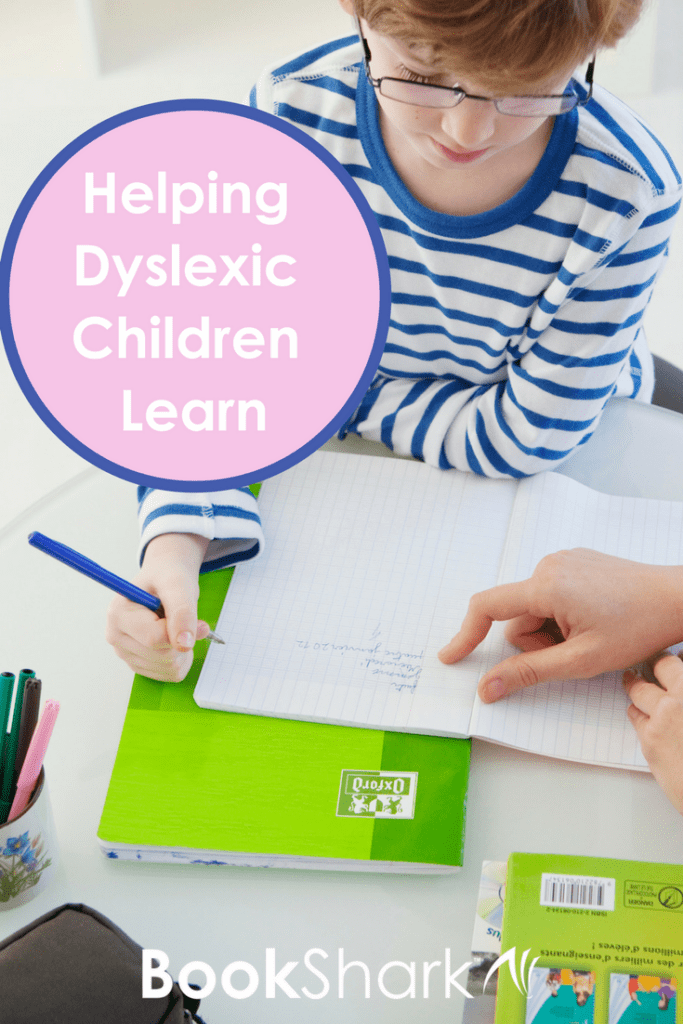




Dyslexia and the Homeschooled Child

Having a child who has been diagnosed with dyslexia can be overwhelming for any parent. For the homeschool mom, it can seem especially intimidating, but it doesn’t have to be. Since homeschooling offers flexibility and individualized instruction, it is the perfect environment to foster learning for the child with dyslexia.
Children with dyslexia process information differently. Therefore, they must be taught differently, or frustration, stagnation, and feelings of defeat can compound their struggles. To become readers and writers, they need to learn and access information the way their brains process information.
“Dyslexia is a neurological condition caused by a different wiring of the brain. There is no cure for dyslexia and individuals with this condition must learn coping strategies. Research indicates that dyslexia has no relationship to intelligence. Individuals with dyslexia are neither more nor less intelligent than the general population. But some say the way individuals with dyslexia think can actually be an asset in achieving success.”¹
A Multisensory Approach
Research shows that a multisensory approach helps a child with dyslexia learn.
“When taught by a multisensory approach, students have the advantage of learning alphabetic patterns and words with engagement of all learning modalities. Dr. Samuel Terry Orton, one of the first to recognize the syndrome of dyslexia in students, suggested that teaching the fundamentals of phonic association with letterforms, both visually presented and reproduced in writing until the correct associations were built up, would benefit students of all ages.”²
What is a multisensory approach? A child with dyslexia needs information repeated to them in a variety of ways. Therefore, using visual, auditory, and kinesthetic-tactile activities helps children learn and later access the information they’ve learned. A multisensory approach is the glue that helps what a child learns to stick to their brain.
A child with dyslexia also needs time and support. They need to learn at their own pace, in small groups or one-on-one. Below are a few strategies and resources to help children with dyslexia find success.
Reading and Spelling Strategies
When teaching letter sounds and how to identify them with their matching symbol, direct instruction works well. You can also use this method to help them learn to count syllables and to understand the six basic syllable types. Teaching about rhyming, base words, roots, and prefixes and suffixes also works well with direct instruction.
Repetition is Key
For a child who has been diagnosed with dyslexia, repetition is of utmost importance. There are multiple ways to incorporate this into daily learning. Children love to play learning games, which lend themselves easily to repetition. Another fun way to teach is by singing songs. This works especially well with younger children. However, older students can also benefit by repeating words, phrases, and facts set to music.
Keeping words with similar spelling patterns together is a simple trick that facilitates learning. Additionally, help your child to compile a list of their most commonly misspelled words. Then encourage them to practice the words regularly. Mix it up by using letter tiles to build words. Or give them some old-fashioned tracing paper to use with pre-printed words. Word search games are also a fun way for your child to learn.
Make use of your read-aloud time by having your child track the words and follow along. This also works with audiobooks. Or get them involved by taking turns reading aloud. Make sure that you read books that interest them. Let them have some fun by using graphic novels and comic books. This helps to break long passages into smaller parts to encourage learning without becoming overwhelmed.
Another creative way to incorporate repetition is to let children draw or write about what they’re reading. They can also make related hands-on projects. These might include making movies, games, or 3D projects that depict scenes from their reading material.
Reading Comprehension Strategies
Implement a variety of strategies while reading. For example, you can pause after a passage, page, or chapter and discuss what they’ve read.
Use different types of questions as teaching tools. Your child can better understand how to make connections when you ask how they relate to the story or its characters. Teach them how to make predictions by asking what they think will happen next in the story. Help them to learn to make comments about a story by asking what they think, like, or dislike about it. And show them how to recognize inferences in a story by asking what they understand even though it isn’t directly stated.
Your child learns to summarize for clarity when you ask them to explain what has happened so far in the story. You can also teach them to visualize by asking what they see in their mind as they listen.
Writing Strategies

As with reading, direct instruction is a good way to teach writing. It helps when learning fine motor skills and letter formation, along with the mechanics of grammar and sentence structure. Additionally, when teaching them how to break ideas into smaller parts, direct instruction is the most effective. They can also learn to organize their ideas using graphic organizers.
Variety of Tools
With young children, practice writing with fun pens, glitter glue, in salt or sand. Also, you can make words out of playdough or trace them in the air.
Typing might be a better solution for older kids. Assistive technology like Dragon, Naturally Speaking, Kurzweil, a Livescribe Smartpen, and Read&Write are good resources for reading, spelling, and writing.
Interest is Key
Let kids choose their topics and genres. Writing assignments that have a purpose and are meaningful to the child will encourage them to practice. Think outside the box. Emails, Minecraft, invitations, and comic books can be creative ways to assign writing. Even submitting reviews and comments on their favorite YouTube videos can allow them to practice writing.
The Writing Process
First of all, teach your child to brainstorm. They can use graphic organizers to plan their ideas and information. Then, they are ready to write their first draft and begin any necessary revisions.Typing can eliminate the frustration of having to re-write drafts over and over.
Help to simplify the proofreading process. Ask kids to look for only one type of error at a time. Teach them to use proofreading sheets and word walls as aids in the writing process.
Help Them Thrive
It is important that a child with dyslexia practices reading and writing in a variety of ways. Because of this, they need daily practice for short periods of time. Use materials and activities that offer a multisensory approach, repetition, and direct instruction.
Furthermore, children with dyslexia need to spend time doing the things they love, feeling success, and letting their brains relax. A child with dyslexia needs to learn differently. As homeschool moms, we can help them thrive by offering the support, strategies, and resources they need.
“Dyslexic kids are creative,outside-the-box thinkers. They have to be, because they don’t see or solve problems the same way other kids do. In school, unfortunately, they are sometimes written off as lazy, unmotivated, rude or even stupid. They aren’t. Making Percy dyslexic was my way of honoring the potential of all the kids I’ve known who have those conditions. It’s not a bad thing to be different. Sometimes, it’s the mark of being very, very talented.” —RickRiordan.com
NOTES
¹“Multisensory Structured Language Teaching Fact Sheet.” International Dyslexia Association | …until Everyone Can Read!, dyslexiaida.org/multisensory-structured-language-teaching-fact-sheet/.
²“Dyslexia At a Glance.” International Dyslexia Association | …until Everyone Can Read!, dyslexiaida.org/dyslexia-at-a-glance/.

About the Author
Kelly left teaching middle and high school English to homeschool her children and reclaim how she and her family spent their time. Followers of interest-led learning, her family’s days rarely look the same, but they tend to include a lot of books, art supplies, and time outside.
Kelly facilitates local writing circles for women and children, leads classes on Outschool, and blogs about nurturing the love of learning on her blog, Curiosity Encouraged. She loves to journal, read memoirs, hike, and travel. She seeks quiet mornings and good coffee daily.
